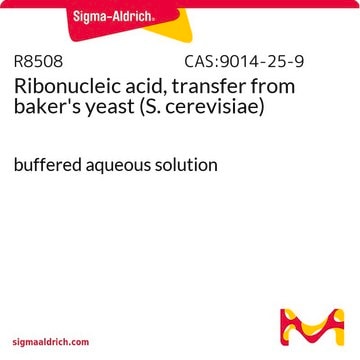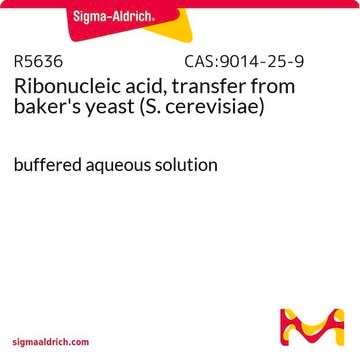This product is considered salt free. Following purification by Ion exchange chromatography, the material is precipitated in ethanol, washed, and finally dialyzed against water prior to lyophilization.
R1753
Ribonukleinsäure, Transfer aus E. coli
Type XX, Strain W, lyophilized powder
Synonym(e):
Transfer-RNA, tRNA
About This Item
Empfohlene Produkte
Suchen Sie nach ähnlichen Produkten? Aufrufen Leitfaden zum Produktvergleich
Anwendung
Einheitendefinition
Hinweis zur Analyse
Lagerklassenschlüssel
11 - Combustible Solids
WGK
WGK 3
Flammpunkt (°F)
Not applicable
Flammpunkt (°C)
Not applicable
Persönliche Schutzausrüstung
Eyeshields, Gloves, type N95 (US)
Hier finden Sie alle aktuellen Versionen:
Analysenzertifikate (COA)
Die passende Version wird nicht angezeigt?
Wenn Sie eine bestimmte Version benötigen, können Sie anhand der Lot- oder Chargennummer nach einem spezifischen Zertifikat suchen.
Besitzen Sie dieses Produkt bereits?
In der Dokumentenbibliothek finden Sie die Dokumentation zu den Produkten, die Sie kürzlich erworben haben.
-
R1753 Ribonucleic acid,CAS Number 9014-25-9, transfer from Escherichia coli. Is it desalted?
1 answer-
Helpful?
-
-
R1753 Ribonucleic acid,CAS Number 9014-25-9, transfer from Escherichia coli. Is it purified E. coli tRNA?
1 answer-
The product is isolated from Escherichia coli. It is soluble in water at 2 mg/ml, producing a clear, colorless solution.
Helpful?
-
-
What is the meaning of "type XX" in R1753?
1 answer-
There are three classes of RNA: Messenger, Ribosomal, and Transfer. The type designations on products offered by Sigma are in-house designations and do not represent any specific biochemical significance. These designations can refer to the order of addition of the product to the catalog, source of material, method of preparation, differences in specifications, and so on.
Helpful?
-
-
I am confused about this reagent based on the application vs. analysis note. Does this product contain deacylated tRNA or is it a mixture of various aminoacylated tRNAs?
1 answer-
This product is just deacylated tRNA. It is tested for tRNA for multiple amino acids.
Helpful?
-
-
What is the Department of Transportation shipping information for this product?
1 answer-
Transportation information can be found in Section 14 of the product's (M)SDS.To access the shipping information for this material, use the link on the product detail page for the product.
Helpful?
-
-
Can Product R1753, tRNA, be used in molecular biology applications?
1 answer-
This product has not been tested for Dnase or RNase activity. Product Nos. R5636 and R8508 are from baker's yeast; they have been tested for DNase and Nickase.
Helpful?
-
-
How many mgs of tRNA, Product R1753, come in the 100UN, 500UN, 2KU and 10KU package sizes?
1 answer-
The amount of powder will vary between lots depending on the activity. For example, a Certificate of Analysis of a lot may say 18 A260 units/mg solid. This means that the 100UN package will contain approxomately 5.56 mg of solid.
Helpful?
-
Active Filters
Unser Team von Wissenschaftlern verfügt über Erfahrung in allen Forschungsbereichen einschließlich Life Science, Materialwissenschaften, chemischer Synthese, Chromatographie, Analytik und vielen mehr..
Setzen Sie sich mit dem technischen Dienst in Verbindung.








